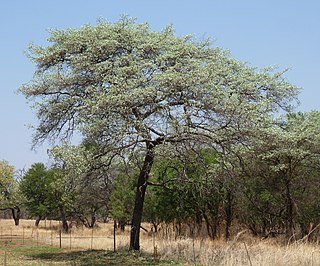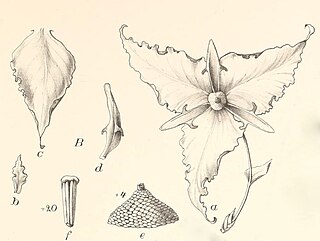
Strychnos nux-vomica, the strychnine tree, also known as nux vomica, poison fruit, semen strychnos, and quaker buttons, is a deciduous tree native to India and to southeast Asia. It is a medium-sized tree in the family Loganiaceae that grows in open habitats. Its leaves are ovate and 5–9 centimetres (2–3.5 in) in size. It is known for being the natural source of the extremely poisonous compound strychnine.

Terminalia is a genus of large trees of the flowering plant family Combretaceae, comprising nearly 300 species distributed in tropical regions of the world. The genus name derives from the Latin word terminus, referring to the fact that the leaves appear at the very tips of the shoots.

Terminalia catappa is a large tropical tree in the leadwood tree family, Combretaceae, native to Asia, Australia, the Pacific, Madagascar and Seychelles. Common names in English include country almond, Indian almond, Malabar almond, sea almond, tropical almond, beach almond and false kamani.

Terminalia elliptica is a species of Terminalia native to southern and southeast Asia in India, Nepal, Bangladesh, Myanmar, Thailand, Laos, Cambodia, and Vietnam. It is a prominent part of both dry and moist deciduous forests in southern India up to 1000 m.

Tilia americana is a species of tree in the family Malvaceae, native to eastern North America, from southeast Manitoba east to New Brunswick, southwest to northeast Oklahoma, southeast to South Carolina, and west along the Niobrara River to Cherry County, Nebraska. It is the sole representative of its genus in the Western Hemisphere, assuming T. caroliniana is treated as a subspecies or local ecotype of T. americana. Common names include American basswood and American linden.

Toona ciliata is a forest tree in the mahogany family which grows throughout South Asia from Afghanistan to Papua New Guinea and Australia.

Terminalia chebula, commonly known as black- or chebulic myrobalan, is a species of Terminalia, native to South Asia from Pakistan, India and Nepal east to southwest China (Yunnan), and south to Sri Lanka, Malaysia, and Vietnam.

Combretum padoides, the thicket bushwillow, occurs in the lowlands of tropical and south-eastern Africa. They grow in a range of habitats from muddy riverbanks to dry rocky hillsides. The mostly opposite oval leaves are carried on long slender branches. The trees or shrubs flower in profusion in mid-summer and the 4-winged fruits reach maturity from late summer to mid winter.
Terminalia ivorensis is a species of tree in the family Combretaceae, and is known by the common names of Ivory Coast almond, idigbo, black afara, framire and emeri.

The Gibson Futura was an electric guitar that was the precursor of the model introduced as the Explorer. These prototypes, christened "Futura" many years later, resembled the eventual Explorer design, but had a differently-proportioned body, as well as a 'split' or 'forked' headstock that survived into the first few production Explorers but was quickly replaced. Gibson obtained U.S. Design Patent number 181,865 for the Futura body shape.

Combretum glutinosum is a shrub species of the genus Combretum, found in the Sahel belt in parts of Senegal, Burkina Faso, Ghana, Mali, the Gambia, Niger, Nigeria and Cameroon, across to parts of Sudan. It is known as dooki in Pulaar, Kantakara in Hausa, rat in Wolof and jambakatan kè in Maninka. Its synonyms are Combretum cordofanum Engl. & Diels, C. passargei Engl. & Diels, C. leonense Engl. & Diels.

Terminalia sericea is a species of deciduous tree of the genus Terminalia that is native to southern Africa. Its common names include clusterleaf, silver cluster-leaf or silver terminalia in English, vaalboom in Afrikaans and mususu in Venda.

Klainedoxa gabonensis is a large tropical African tree of the family Irvingiaceae growing to 40m in height. Its straight trunk is buttressed and up to 25m long, while its spreading evergreen crown makes it one of the largest trees of the rainforest. It is found from Senegal to Sudan, Cameroons, Ivory Coast, Democratic Republic of the Congo, Uganda and Tanzania, growing as far south as Angola and Zambia.

Combretum hereroense, commonly known as the russet bushwillow and the mouse-eared combretum, is a deciduous shrub or small tree that is found from eastern Africa to northern South Africa. Over its extensive range it is variable with respect to leaf shape, fruit size and indumentum.

Pteleopsis myrtifolia is one of some 10 African species in this genus in the family of Combretaceae. It is the only Pteleopsis species to occur in Southern Africa. Its flowers are strongly scented and perceived by humans to be either 'honey-like' or 'cloying' or even 'stinky'. The timber is red, hard and durable, and used for furniture and construction.

Monodora minor is a species of plant in the family Annonaceae. It is native to Mozambique and Tanzania. Heinrich Gustav Adolf Engler and Ludwig Diels, the German botanists who first formally described the species, do not explicitly explain the specific epithet but it is among the smaller members of the genus which includes species that reach heights of 30-40 meters.
Terminalia polycarpa is a small African tree in the family Combretaceae. It is native to Ethiopia, Kenya, and Somalia. The flowers are white or cream in hairy spikes up to 11 cm (4.3 in) long.
Xylopia staudtii Engl & Diels is a tall tree within the Annonaceae family, it can grow up to 50 meters tall, the tallest height of the African Xylopia trees. It occurs in forest and freshwater swamps in West Africa.

Lannea microcarpa is a dioecious plant within the Anacardiaceae family. It is also called African grapes and occurs in the Sudan and Guinea savanna of West Africa from Senegal to Cameroon. The plant is used to dye basilan fini, a traditional cloth in a red and brown colour.





















